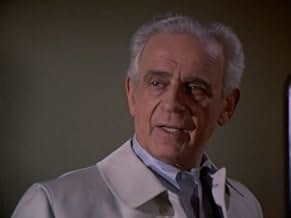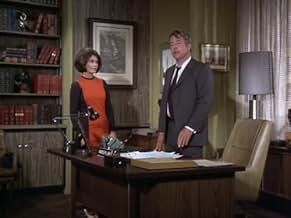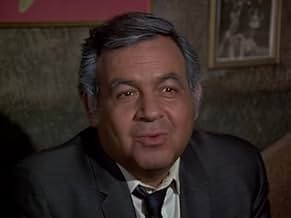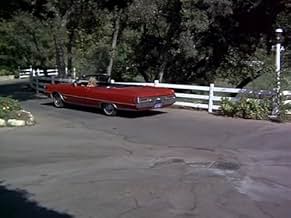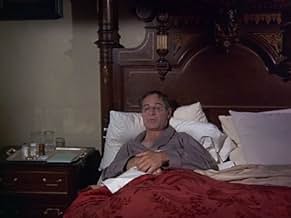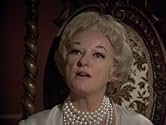Ajouter une intrigue dans votre langueRod Serling presents tales of horror illustrated in various paintings.Rod Serling presents tales of horror illustrated in various paintings.Rod Serling presents tales of horror illustrated in various paintings.
- Nommé pour 2 Primetime Emmys
- 2 victoires et 4 nominations au total
Parcourir les épisodes
Avis à la une
Rod Serlings follow up to Twilight Zone. This series originally began as a four in one alternating with three other shows and each would get one airing per month. Night Gallery was easily the best and became a weekly. While Twilight Zone dealt with Science Fiction Gallery dealt on the macabre horror side. Rod as host would introduce each story via a painting.
A few (mostly the short ones) had tongue in cheek humor. The others could be very spooky. The theme music was equally eerie. The show now airs on the Sci-Fi channel. Having watched it when it originally aired it seems that the episodes are edited here and there. Later episodes were added from another series entitled The Sixth Sense and they were not nearly as good as the Serling ones.
A few (mostly the short ones) had tongue in cheek humor. The others could be very spooky. The theme music was equally eerie. The show now airs on the Sci-Fi channel. Having watched it when it originally aired it seems that the episodes are edited here and there. Later episodes were added from another series entitled The Sixth Sense and they were not nearly as good as the Serling ones.
Caught a few episodes of this once again, as part of a Memorial Day marathon on Encore's MYSTERY! Channel. In spite of the fact that it was mostly reviled by critics and not a few viewers, when it originally ran on NBC back in the early '70's, it now has garnered a cult following and I can definitely see why.
GALLERY in its own way, did for horror anthologies what TWILIGHT ZONE did for science fiction and fantasy. It's not as good as ZONE was in most respects, and I don't think that Rod Serling intended it to be. Free of the pressure of topping himself, which was something damn near impossible to do, GALLERY could be wildly uneven in the way the stories were featured, as it has been mentioned before, in terms of both quantity and quality. One story could take up an entire hour, while a half-hour tale could be accompanied by much shorter vignettes, some of them no more than LOVE, AMERICAN STYLE-quality blackouts, albeit it with endings that feature mayhem rather than marriage, though just as hokey.
A lot of the clothes, the special effects, the skewed photographic angles and lighting are positively outdated by today's standards, but that is a big part of the charm of revisiting a lot of the episodes, many which are all too familiar to the generation that grew up with GALLERY and its peer programs from this particular era.
Even more fascinating, however, is the chance to see movie and TV veterans rubbing elbows and sharing scenes with many "newbies," a lot of whom are established stars today, and the chance to see them cutting their teeth on '70's material is an interesting and sometimes enlightening experience. For example, one episode I viewed featured Kim Hunter, Harry Morgan and a very young Randy Quaid; another starred an up-and-coming actor named Bill Bixby, with Carol Lynley, Ned Glass and Donna Douglas (yes, as in "Ellie Mae Clampett," but without most of her corn-pone accent.)
Based on classic short stories by everyone from August Derleth and H.P. Lovecraft ("Pickman's Model"), to Charles Beaumont and Ray Bradbury, the adaptations varied in quality, but usually never suffered as much as the original stories. Even so, there were scripts, directing and acting that are still every bit as good as anything produced today, better even, since anthology shows such as this are in woefully short supply (though the revamped THE OUTER LIMITS is in reruns, and I've heard a new version of THE TWILIGHT ZONE is in the works.)
Case in point, is one of the episodes I saw in the marathon, called THE WAITING ROOM. From an original Rod Serling story, directed by one of the resident GALLERY helmers, Jeannot Szwarc, this was a masterfully dark Old West tale with a twist, and a Who's-Who of a cast that would put any character actor buff or fan of Western potboilers into High Noon Heaven: Steve Forrest, Buddy Ebsen, Lex Barker, Albert Salmi, Jim Davis and Gilbert Roland. This tale brought to mind a movie TNT did not so long ago called PURGATORY, but where that film needed ninety minutes, this episode delivered a similar punch in thirty.
Of course, there is the now-legendary work done in both the pilot movie and the series by some young, green, but talented kid with the unlikely last name of Spielberg, but if you should happen to catch this while channel-surfing, look beyond those prejudicial impressions, stop and give it a chance, especially if you haven't seen it in quite a while. There are plenty of misses that were made during GALLERY'S three-season run, but the hits, which can still leave trails of cranberry-sized goosebumps down the back of your spine, are definitely worth it. Don't believe me? Well, you'll know whether or not NIGHT GALLERY can still have an effect on you, if you still shudder when you read my closing sentence...
"...and the FEMALE LAYS EGGS...."
GALLERY in its own way, did for horror anthologies what TWILIGHT ZONE did for science fiction and fantasy. It's not as good as ZONE was in most respects, and I don't think that Rod Serling intended it to be. Free of the pressure of topping himself, which was something damn near impossible to do, GALLERY could be wildly uneven in the way the stories were featured, as it has been mentioned before, in terms of both quantity and quality. One story could take up an entire hour, while a half-hour tale could be accompanied by much shorter vignettes, some of them no more than LOVE, AMERICAN STYLE-quality blackouts, albeit it with endings that feature mayhem rather than marriage, though just as hokey.
A lot of the clothes, the special effects, the skewed photographic angles and lighting are positively outdated by today's standards, but that is a big part of the charm of revisiting a lot of the episodes, many which are all too familiar to the generation that grew up with GALLERY and its peer programs from this particular era.
Even more fascinating, however, is the chance to see movie and TV veterans rubbing elbows and sharing scenes with many "newbies," a lot of whom are established stars today, and the chance to see them cutting their teeth on '70's material is an interesting and sometimes enlightening experience. For example, one episode I viewed featured Kim Hunter, Harry Morgan and a very young Randy Quaid; another starred an up-and-coming actor named Bill Bixby, with Carol Lynley, Ned Glass and Donna Douglas (yes, as in "Ellie Mae Clampett," but without most of her corn-pone accent.)
Based on classic short stories by everyone from August Derleth and H.P. Lovecraft ("Pickman's Model"), to Charles Beaumont and Ray Bradbury, the adaptations varied in quality, but usually never suffered as much as the original stories. Even so, there were scripts, directing and acting that are still every bit as good as anything produced today, better even, since anthology shows such as this are in woefully short supply (though the revamped THE OUTER LIMITS is in reruns, and I've heard a new version of THE TWILIGHT ZONE is in the works.)
Case in point, is one of the episodes I saw in the marathon, called THE WAITING ROOM. From an original Rod Serling story, directed by one of the resident GALLERY helmers, Jeannot Szwarc, this was a masterfully dark Old West tale with a twist, and a Who's-Who of a cast that would put any character actor buff or fan of Western potboilers into High Noon Heaven: Steve Forrest, Buddy Ebsen, Lex Barker, Albert Salmi, Jim Davis and Gilbert Roland. This tale brought to mind a movie TNT did not so long ago called PURGATORY, but where that film needed ninety minutes, this episode delivered a similar punch in thirty.
Of course, there is the now-legendary work done in both the pilot movie and the series by some young, green, but talented kid with the unlikely last name of Spielberg, but if you should happen to catch this while channel-surfing, look beyond those prejudicial impressions, stop and give it a chance, especially if you haven't seen it in quite a while. There are plenty of misses that were made during GALLERY'S three-season run, but the hits, which can still leave trails of cranberry-sized goosebumps down the back of your spine, are definitely worth it. Don't believe me? Well, you'll know whether or not NIGHT GALLERY can still have an effect on you, if you still shudder when you read my closing sentence...
"...and the FEMALE LAYS EGGS...."
Everyone knows the genius of Rod Serling's science fiction, suspense series, THE TWILIGHT ZONE. NIGHT GALLERY was a different sort of series, bringing horror to the small screen. Stories by the likes of H.P. Lovecraft, Richard Matheson, and Robert Bloch were presented weekly, in a macabre art museum setting. Serling himself was the "curator" / host. Each episode was like a mini-feature film. There was great care and quality involved.
The reason this show never reached the same stellar status that TTZ did is easy to discern. While the first season is filled with many classic episodes featuring supernatural, sometimes surreal tales, studio meddling and economic pressures doomed the later seasons to a more conventional TV hell.
The network -obviously- was only concerned with better ratings / profit, so, it demanded shorter segments, more "accessible" stories, and, of course, comedy. Serling, being the eternal iconoclast, hated this nonsense, but had no real choice. If it had all been done his way, without the tampering, NIGHT GALLERY would have been a horror masterpiece. As it stands, it has the first season of brilliance, followed by a second decent season, and a third that is hit and miss. Still, this show was unique, and even its worst episodes were better than most of the rubbish on TV...
The reason this show never reached the same stellar status that TTZ did is easy to discern. While the first season is filled with many classic episodes featuring supernatural, sometimes surreal tales, studio meddling and economic pressures doomed the later seasons to a more conventional TV hell.
The network -obviously- was only concerned with better ratings / profit, so, it demanded shorter segments, more "accessible" stories, and, of course, comedy. Serling, being the eternal iconoclast, hated this nonsense, but had no real choice. If it had all been done his way, without the tampering, NIGHT GALLERY would have been a horror masterpiece. As it stands, it has the first season of brilliance, followed by a second decent season, and a third that is hit and miss. Still, this show was unique, and even its worst episodes were better than most of the rubbish on TV...
I grew up watching this as a really little kid in Brooklyn, my family loved this show and it's probably the reason I still suffer from Night Terrors to this DAY! I was 5 when I saw 1971 episode THE DOLL. (there are 2 different doll episodes, I think the other is from 73 and is called Doll of Death)
Anyhoo, I was SO FREAKED out from watching that 71 The Doll episode that I still remember having horrible nightmares as a kid and I called the Episode The Doll with the Black Eyes. I couldn't sleep in a room with dolls, and I had a new strange raggedy ann type doll my aunt had just bought me, and she had Solid Black Eyes. I loved that doll, but could not sleep with it in my bed or anywhere in my room at night after this episode. I would make my Mom lock it up every night. Seriously!! I Never wanted to re-watch that episode growing up and even as an adult cannot sleep in any room with dolls. I finally re-watched this in 2004, I'm a grown woman and YES, it still CREEPED ME OUT!! It's like this episode gave me PTSD as a kid, and all those feelings of Terror came flooding back. I know, it sounds crazy, but it's TRUE! I haven't watched it since. LOL I'm creeped out just writing this and remembering how terrorized I felt as a child. Rod Serling was Great and I love him to this day, but his show Freaked me out and left my sleep disturbed to this day. But weird thing is I always Loved Horror Movies and can watch The Walking Dead alone at night with no problems, but Don't play the Doll with the Black Eyes for me, cause I don't think I will sleep for days. :o Great old school series with alot of creepy and disturbing episodes. ;D.
I vaguely remember watching this show when I was a small child when it was a regular series. I watched it in syndication when I was an adolescent and have watched it as an adult on the Sci-Fi channel, so I guess that you could say I have had a chance to view Night Gallery from three very different perspectives. Rod Serling was a true genius who was often called television's "first angry man". What I mean is that he wrote scripts for tv that dealt with real social issues and were not meant as fluff entertainment. He wanted to send out a message with the stories that he wrote. Serling wrote such classic screenplays as Requium For A Heavywieght and Patterns. He probably would not have liked it that he was best remembered for The Twilight Zone! Night Gallery was the last series he hosted before his untimely death in 1975. Each episode had about three or four stories. Of course they didn't hit the target with all of them, but they still had a good batting average! Some of the episodes were disturbing and terrifying and some were just meant to be merely humerous. I remember one with Leslie Nielsen as the Phantom of the Opera (keep in mind this was before the Naked Gun and Police Squad when he was a dramatic actor). The girl unmasked him and he unmasked her and found she was as deformed as he was! They had another episode that I clearly remember about a time traveler who was a survivor of the Titanic who was picked up by the Lusitania who was then rescued by the Andrea Doria! The one that I remember the most, the one that chilled me was the one about a boy who could see the future and then described a horrifying vision where the sun would explode (a nova) and would incinerate the earth! The fun part of this show was the high quality of the guest stars that they had everyone from Burgess Meredith to Ozzie and Harriet Nelson to Leonard Nimoy. Gary Collins was Night Gallery's most frequent guest star, he played a parapsychologist named Doctor Rhode's who investigated all kinds of odd cases and his character was so popular that he even got his own series. I always enjoyed every episode that Mister Collins was in. People don't realize this, but the original Night Gallery movie in 1969, the series pilot was one of the first television movies ever made! In fact, one of the directors who did one of the stories was a young man named Steven Spielburg! The story I most remember from the pilot was one with Richard Kiley as a Nazi War Criminal who meets a truly just and horrifying end. A man who put too many Christs on crosses for any God to give him forgiveness! Rod Serling fought in World War II as a paratrooper and was severely wounded. His wife said in an interview that he never stopped having nightmares about the war and many of the stories he wrote for the Twilight Zone and Night Gallery deal with the horrors of war. Rod Serling was a true genius who wrote stories that entertained us and made us think at the same time.
Le saviez-vous
- AnecdotesArtist Thomas J. Wright painted all of the paintings used to introduce each story.
- Citations
Rod Serling: For those of you who've never met me, you might call me the under-nourished Alfred Hitchcock.
- Versions alternativesMajor changes were made to most episodes for syndication. The 60-minute episodes were edited down to 30 minute packages, with major edits to some of the 30-40 minute segments of the original shows. In cases of segments that were only 15-20 minutes in length, these were padded out by adding stock footage, newly shot scenes, and footage from Hollywood movies such as Silent Running (1972) and Fahrenheit 451 (1966). Most musical cues were also replaced for syndication. In order to augment "Night Gallery"'s syndicated run, episodes of Le sixième sens (1972) were edited down to 30 minutes, had new introductions by Rod Serling tacked on, and were added to the syndicated run of "Night Gallery."
- ConnexionsEdited from Four-In-One (1970)
Meilleurs choix
Connectez-vous pour évaluer et suivre la liste de favoris afin de recevoir des recommandations personnalisées
- How many seasons does Night Gallery have?Alimenté par Alexa
Détails
- Date de sortie
- Pays d’origine
- Langue
- Aussi connu sous le nom de
- Rod Serling's Night Gallery
- Lieux de tournage
- Société de production
- Voir plus de crédits d'entreprise sur IMDbPro
- Durée
- 50min
- Mixage
- Rapport de forme
- 1.33 : 1
Contribuer à cette page
Suggérer une modification ou ajouter du contenu manquant


